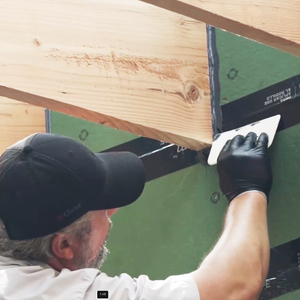I think I know what a load bearing wall is; a structural member of the building instead of a stud and sheetrock divider, right? unless I am totally wrong about that first assumption my question is, when I look at a building how do I know if a wall is load bearing? is there a rule of thumb, or a characteristic to look for that says that a wall is load bearing?
-z


















Replies
Typically, a load bearing wall runs perpendicular to the joists above it. If you have an accessible view from the basement or attic, it's pretty easy to determine.
As far as a rule of thumb, with a rectangular building footprint, builders will usually lay out the joists so that they take the shorter of the two spans available. This just makes sense, because it enables the builder to use smaller cross-sections, and thus, costs less. But it's always important to make a direct visual observation (or use a studfinder if you can find one that works) to make sure your assumptions are correct before tearing down walls.
Ragnar
Depending on the age of the home, sometimes it's fairly easy to tell, other times not. Usually you can tell from the supports in the basement or crawlspace. Sometimes you can tell by how walls line up from one story to another. Unfortunately, there are no cut and dry rules. My house has no bearing walls. It has old hand hewn beams running between each floor running into solid brick walls.
If it's too difficult to figure out, getting someone to point what is what to you should not be an expensive proposition. Shouldn't take long at all. A lot of it just comes from experience and seeing the same style of construction over and over again. Then again, many of the old victorians don't have anything that lines up.
Don
You could have two identical walls, each made of 2x4's and sheetrock, and one could be bearing and the other not, so the type of construction is not a good guide.
This question comes up often enough that I've saved up the following collection of information about it. Of course, I'd welcome any additions or corrections.
-- J.S.
How to identify bearing walls:
When somebody asks how to identify load bearing walls, it's usually
because they're thinking of removing a wall or cutting a big hole in
one. That can be serious business, not something that can be designed
adequately by using a FAQ from the internet. The following discussion
may be useful for the preliminary speculation phase of such a project,
but don't rely on it for anything more.
Removing a load bearing wall is not impossible, but it is more
expensive. Often much more expensive. It will require some sort of
substitute support for the weight it carried, usually a beam. Often
this beam will have to be large enough that it extends downward from
the ceiling fairly far. On a top floor, you may be able to hide it in
the attic, and hang the ceiling joists from the side of it. But often
the ugly beam sticking down, which always looks like you took out a
wall, defeats the architectural purpose of removing the wall in the
first place.
You'll also have to provide adequate support under the ends of the
beam, because the load that was formerly distributed along the length
of the wall is now concentrated there. This load has to be supported
all the way down to the ground.
Most people at this point should hire a structural engineer. If you
don't want to hire an engineer, get some engineering books from the
library. Unless you have a very strong technical and math background,
that kind of light reading will probably convince you to pay somebody
who already knows this stuff.
The official code definition of a bearing wall is any wall that
supports 100 pounds or more per foot of length, and any masonry wall
that supports any additional masonry above its ceiling level. That's
not particularly practical or helpful, since there's no instrument to
measure the weight on the top plate of a wall.
In general, you have to look at what the wall supports, and what
supports it. Walls that are parallel to the joists above are usually
but not always non-bearing. On my top floor, I have a wall parallel
to the joists that supports the rafter tails of a decorative roof
section. On the top floor, always look in the attic to see if the
wall in question carries any roof load. Then look to see if it
supports ceiling joists. If the joist tails rest on a wall, it's
almost always bearing. I have one exception to that upstairs, where
the ceiling joist tails rest on a non-bearing 2x3 wall that was the
partition between two closets, each 10 feet by 27 inches. On each
side, the real bearing walls are only 27 inches from this partition
wall. They form the sides of the stairwell.
In the past, building codes used to allow 2x3's for non-bearing walls.
Now 2x4's are the minimum for all walls. I know that was changed
prior to 1971, but I'm not sure how far prior. It's possible that
you'll find a load bearing 2x3 wall if bootleg remodeling removed a
nearby bearing wall.
For ground floor walls, look in the crawl space or basement. A
bearing wall perpendicular to the joists should be no more than one
joist depth away from some sort of support -- a girder or cripple
wall. That's a code requirement for all walls, not just on the ground
floor. So, if your joists are 2x10's (actually 9 1/4"), and a wall is
10 inches away from the nearest support, it's probably not supposed to
be bearing. The exceptions are if the original design was done by an
engineer, or the building is old enough to pre-date that code.
In old houses, bearing walls parallel to the joists below may have no
extra support. In newer construction, they'll usually have a joist or
two under them. The best practice is two joists with space between
them for utilities to run into the wall without hacking up the
structure. As always, beware of bootleg jobs that may have
transferred loads to walls that legally shouldn't carry them.
The tough part comes when you have three or more stories, and you want
to work on the in-between floors. First, you should start from the
attic and work down, because any bearing wall up there has to be
supported by bearing walls all the way down. Then look in the crawl
or basement, and work your way up. As with the crawl space, the max
is one joist depth away from floor to floor, unless it's an engineered
design or an old building. Next you may need to do some exploratory
demolition of the ceiling to see what's on top of the wall in
question. Again you're looking for joist tails, this time floor joist
tails.
Finally, even if a wall appears to be non-bearing, if it's
perpendicular to the joists above, you have to determine the size of
those joists and the new distance they'll span if the wall is removed.
You can look in the span tables to see if the result will pass code.
Also, non-bearing is merely a legal term used in codes. It doesn't
mean that the wall in question has no structural role. Gravity
doesn't care whether we call a wall bearing or not. After it's gone,
the floor above may be less solid feeling, even though it still passes
code.
Edited 12/26/2002 7:34:48 PM ET by JOHN_SPRUNG
well said!
i wonder how many ER visit each year occur because some clown didnt consult a pro before they took a bearing wall or support column down! hundred? thousands?
pry off a piece of base..there should be a warning " LOAD BEARING WALL" wriiten on the unpainted drywall, probably followed by a skull and crossbones.
In the current FHB on p. 80 there's an article on removing a bearing wall. While it doesn't deal directly with the issue of identifying a wall as load bearing, it does present many of the challenges of removing a bearing wall.
BTW thanks John for the great post
Traditionally bearing walls were considered in the context of gravity and the ability to carry vertical load. But modern seismic and wind load understanding as well as open area design and increased spans have put a lot of structural demand on shear walls and the need to sustain horizontal loads. So even if a wall isn’t holding something up it may be holding something back. Remember that barring catastrophic material or component failure, structures tend not to fall down but rather to fall sideways.
Zach, if the house you're looking at has a slab-on-grade foundation, you can look at the plans to see where the interior footings are located b/c a load-bearing partition usually resides above each interior footing. That will give you a baseline, now get in the attic and see what walls joists lap over and beams rest on.